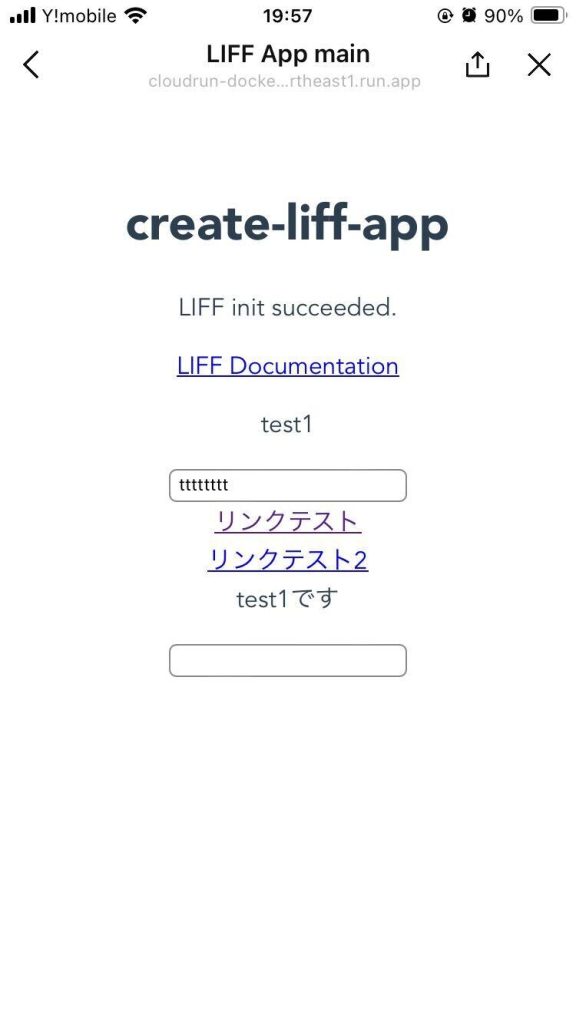こちらの続き
前回までで基本的な環境構築はできているので、
この記事はVueの内容がメインになるかと思います。
「Options API」と「Composition API」
ちょっと本筋からズレちゃいますが、実装を試していく上でハマったので、
Options APIとCompositon APIの書き方の違いについて触れたいと思います。
前の記事でLIFFの開発環境を構築した際は以下のように、
Options APIでソースが生成されていました。
(sendMessagesの部分だけ前回の記事で追加しています)
src/App.vue
<script>
import liff from "@line/liff";
export default {
data() {
return {
message: "",
error: ""
};
},
mounted() {
liff
.init({
liffId: import.meta.env.VITE_LIFF_ID
})
.then(() => {
this.message = "LIFF init succeeded.";
alert(liff.getContext());
liff
.sendMessages([
{
type: "text",
text: "Hello, World!",
},
])
.then(() => {
alert("message sent");
})
.catch((err) => {
alert("error", err);
});
})
.catch((e) => {
this.message = "LIFF init failed.";
this.error = `${e}`;
});
}
};
</script>
<template>
<div>
<h1>create-liff-app</h1>
<p v-if="message">{{ message }}</p>
<p v-if="error">
<code>{{ error }}</code>
</p>
<a href="https://developers.line.biz/ja/docs/liff/" target="_blank" rel="noreferrer">
LIFF Documentation
</a>
</div>
</template>
<style>
#app {
font-family: Avenir, Helvetica, Arial, sans-serif;
-webkit-font-smoothing: antialiased;
-moz-osx-font-smoothing: grayscale;
text-align: center;
color: #2c3e50;
margin-top: 60px;
}
</style>これは古い書き方っぽくて現在のトレンドはCompositon APIだそうなので、
以下のように修正します。
<script setup>
import liff from "@line/liff";
import { ref, onMounted } from "vue";
const message = ref("");
const error = ref("");
onMounted(
function() {
liff
.init({
liffId: import.meta.env.VITE_LIFF_ID
})
.then(() => {
message.value = "LIFF init succeeded.";
liff
.sendMessages([
{
type: "text",
text: "Hello, World!",
},
])
.then(() => {
alert("message sent");
})
.catch((err) => {
alert("error", err);
});
})
.catch((e) => {
message.value = "LIFF init failed.";
error.value = `${e}`;
});
console.log('message:' + message);
console.log("error:"+error);
}
)
</script>
<template>
<div>
<h1>create-liff-app</h1>
<p v-if="message">{{ message }}</p>
<p v-if="error">
<code>{{ error }}</code>
</p>
<a href="https://developers.line.biz/ja/docs/liff/" target="_blank" rel="noreferrer">
LIFF Documentation
</a>
</div>
</template>
<style>
#app {
font-family: Avenir, Helvetica, Arial, sans-serif;
-webkit-font-smoothing: antialiased;
-moz-osx-font-smoothing: grayscale;
text-align: center;
color: #2c3e50;
margin-top: 60px;
}
</style>コードの量が減り見やすくなりました。
この状態で後続に進みます。
子コンポーネントを使用
Vueではパーツごとにコンポーネントという単位でファイルを分けて、
必要に応じて取り込めるということなので、一旦子コンポーネントを作成して表示します。
src配下にcomponentsというフォルダを作成して、
components配下に、CustomTextArea.vueというファイルを以下のように作成します。
<script setup>
const props = defineProps({
'name': String,
'value': String
})
</script>
<template>
<p>{{props.name}}</p>
<input type="text" v-bind:value="value">
</template>次にApp.vueを以下のように変更します。
<script setup>
import liff from "@line/liff";
import CustomTextArea from "./components/CustomTextArea.vue";
import { ref, onMounted } from "vue";
const message = ref("");
const error = ref("");
onMounted(
function() {
liff
.init({
liffId: import.meta.env.VITE_LIFF_ID
})
.then(() => {
message.value = "LIFF init succeeded.";
liff
.sendMessages([
{
type: "text",
text: "Hello, World!",
},
])
.then(() => {
alert("message sent");
})
.catch((err) => {
alert("error", err);
});
})
.catch((e) => {
message.value = "LIFF init failed.";
error.value = `${e}`;
});
console.log('message:' + message);
console.log("error:"+error);
}
)
</script>
<template>
<div>
<h1>create-liff-app</h1>
<p v-if="message">{{ message }}</p>
<p v-if="error">
<code>{{ error }}</code>
</p>
<a href="https://developers.line.biz/ja/docs/liff/" target="_blank" rel="noreferrer">
LIFF Documentation
</a>
</div>
<section>
<CustomTextArea
name="test1"
value="tttttttt" />
</section>
</template>
<style>
#app {
font-family: Avenir, Helvetica, Arial, sans-serif;
-webkit-font-smoothing: antialiased;
-moz-osx-font-smoothing: grayscale;
text-align: center;
color: #2c3e50;
margin-top: 60px;
}
</style>
import文の追加と「<CustomTextArea 〜/>」というタグの追加です。
画面遷移
Vueの機能を使用して、ルーティング機能を追加しようと思います。
URLごとに表示するコンポーネントを出し分けることで画面遷移を実装していきます。
vue-routerをインストールします。(公式サイトはこちら)
$ npm install vue-router@4インストールできたら、main.jsと同じ階層にrouter.jsを作成します。
import { createWebHistory, createRouter } from 'vue-router';
import Test1 from './views/Test1.vue';
import Test2 from './views/Test2.vue';
const routes = [
{
path: '/',
name: 'Test2',
component: Test2,
},
{
path: '/test1',
name: 'Test1',
component: Test1,
},
{
path: '/test2',
name: 'Test2',
component: Test2,
},
]
const router = createRouter({
history: createWebHistory(),
routes,
})
export default router;そして、同じ階層にviewsというフォルダを作成して、その中にTest1.vue、Test2.vueを作成します。
<script setup>
const props = defineProps({
'name': String,
'value': String
})
</script>
<template>
test1です
<p>{{props.name}}</p>
<input type="text" v-bind:value="value">
</template><script setup>
const props = defineProps({
'name': String,
'value': String
})
</script>
<template>
test2です
<p>{{props.name}}</p>
<input type="text" v-bind:value="value">
</template>中身は前回使用したvueファイルをコピーしただけで「test1です」「test2です」という文言だけ追加してます。
続いてmain.jsを修正
import { createApp } from 'vue';
import App from './App.vue';
import router from './router.js';
createApp(App)
.use(router)
.mount('#app');
router.jsを使用できるようにします。
App.vueも修正
<script setup>
import liff from "@line/liff";
import CustomTextArea from "./components/CustomTextArea.vue";
import { ref, onMounted } from "vue";
import { RouterView, RouterLink } from "vue-router";
const message = ref("");
const error = ref("");
onMounted(
function() {
liff
.init({
liffId: import.meta.env.VITE_LIFF_ID
})
.then(() => {
message.value = "LIFF init succeeded.";
liff
.sendMessages([
{
type: "text",
text: "Hello, World!",
},
])
.then(() => {
alert("message sent");
})
.catch((err) => {
alert("error", err);
});
})
.catch((e) => {
message.value = "LIFF init failed.";
error.value = `${e}`;
});
console.log('message:' + message);
console.log("error:"+error);
}
)
</script>
<template>
<div>
<h1>create-liff-app</h1>
<p v-if="message">{{ message }}</p>
<p v-if="error">
<code>{{ error }}</code>
</p>
<a href="https://developers.line.biz/ja/docs/liff/" target="_blank" rel="noreferrer">
LIFF Documentation
</a>
</div>
<section>
<CustomTextArea
name="test1"
value="tttttttt" />
</section>
<section>
<RouterLink to="/test1">リンクテスト</RouterLink>
</section>
<section>
<RouterLink to="/test2">リンクテスト2</RouterLink>
</section>
<section>
<RouterView />
</section>
</template>
<style>
#app {
font-family: Avenir, Helvetica, Arial, sans-serif;
-webkit-font-smoothing: antialiased;
-moz-osx-font-smoothing: grayscale;
text-align: center;
color: #2c3e50;
margin-top: 60px;
}
</style>
修正箇所としてはRouterView, RouterLinkのimport追加
「<RouterLink to=></RouterLink>」でリンク追加
「<RouterView />」でリンクをタップした場合の表示領域の作成です。
画面表示します。まずは「<liff url>/」

「リンクテスト」「リンクテスト2」というリンクが追加されています。
続いて、リンクテストをタップ

test1ですという文言などが表示されます。
続いてリンクテスト2をタップ

test2ですの表示に切り替わりました。
「LIFF×Vue×Flask×Cloud Runアプリ実装(LINEアプリ)②」への5件のフィードバック